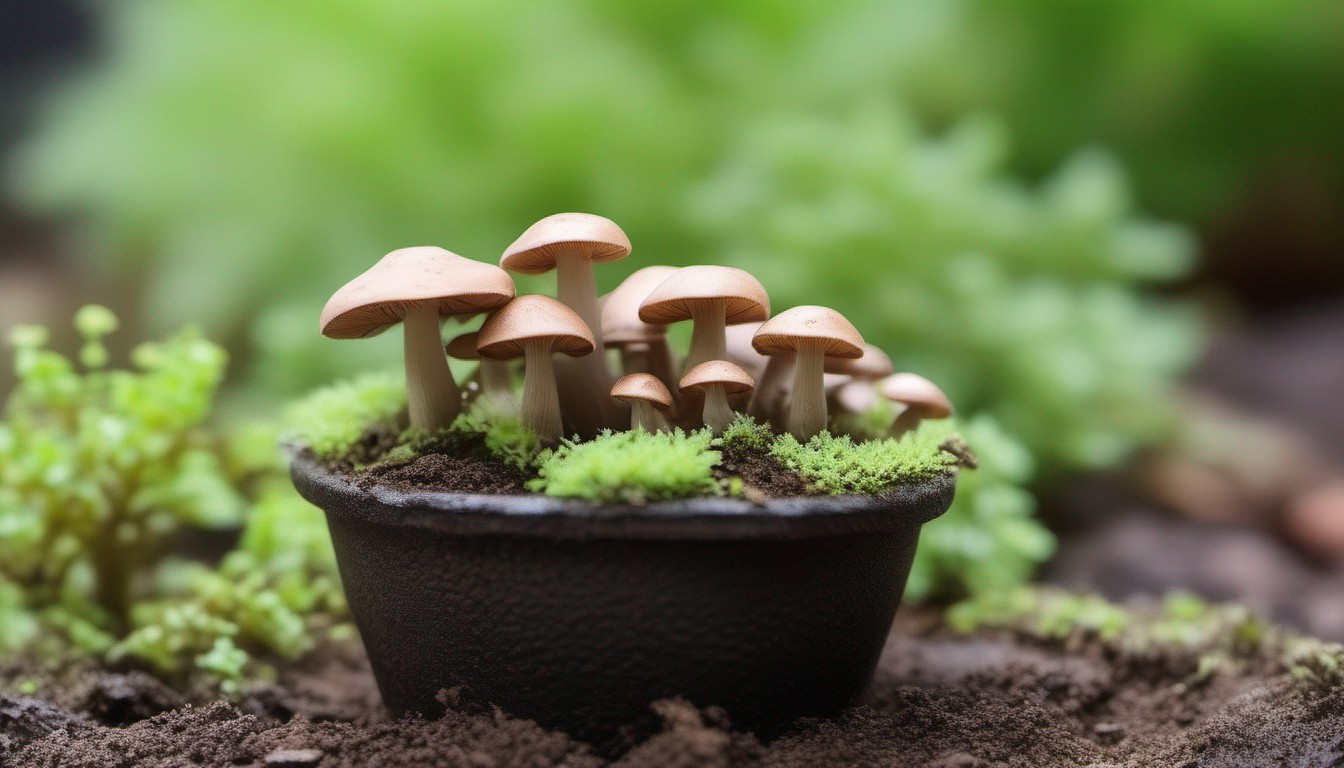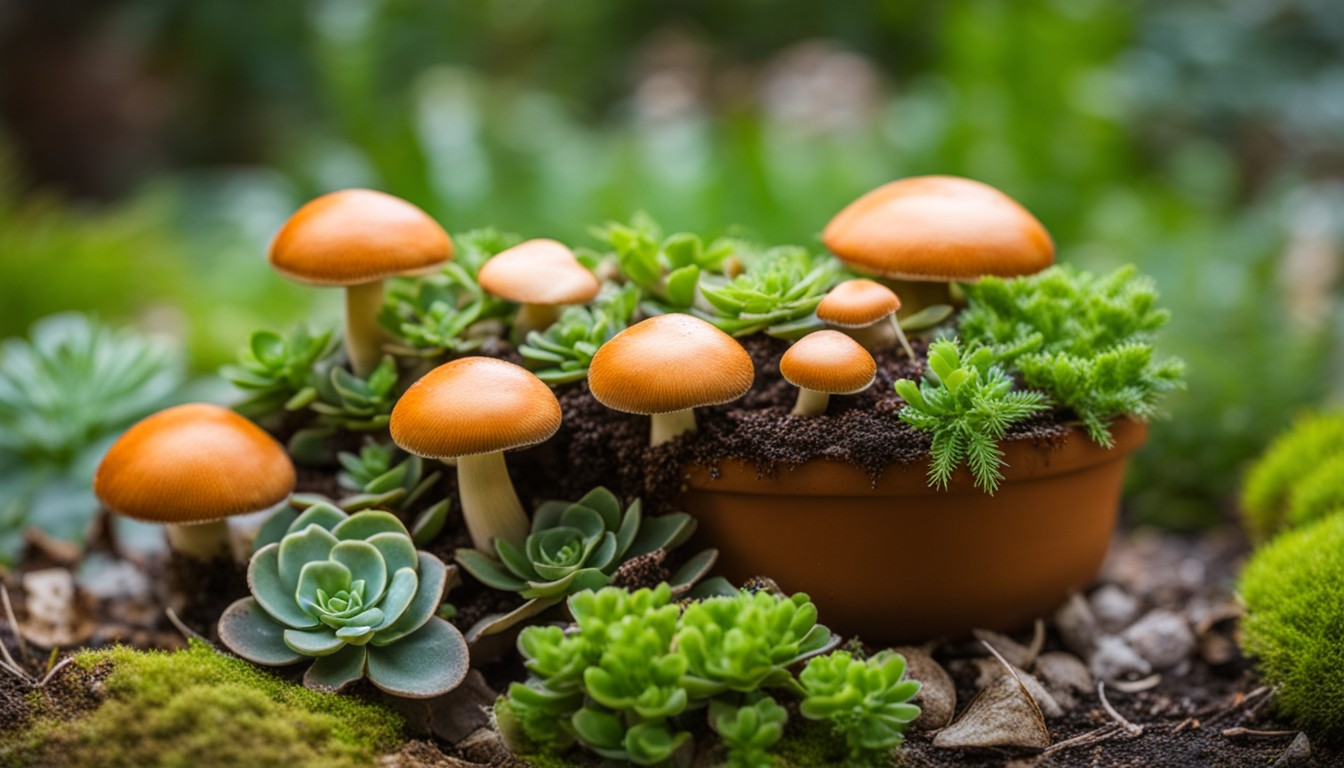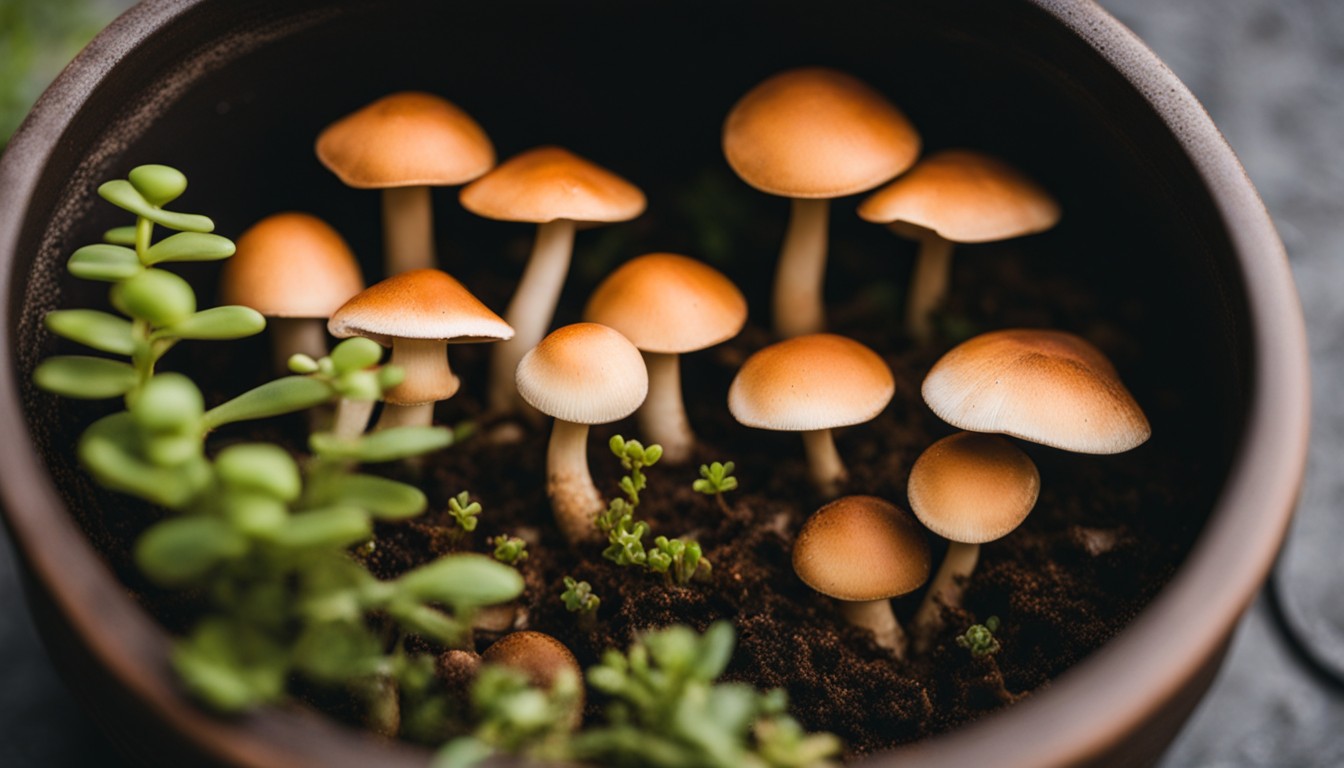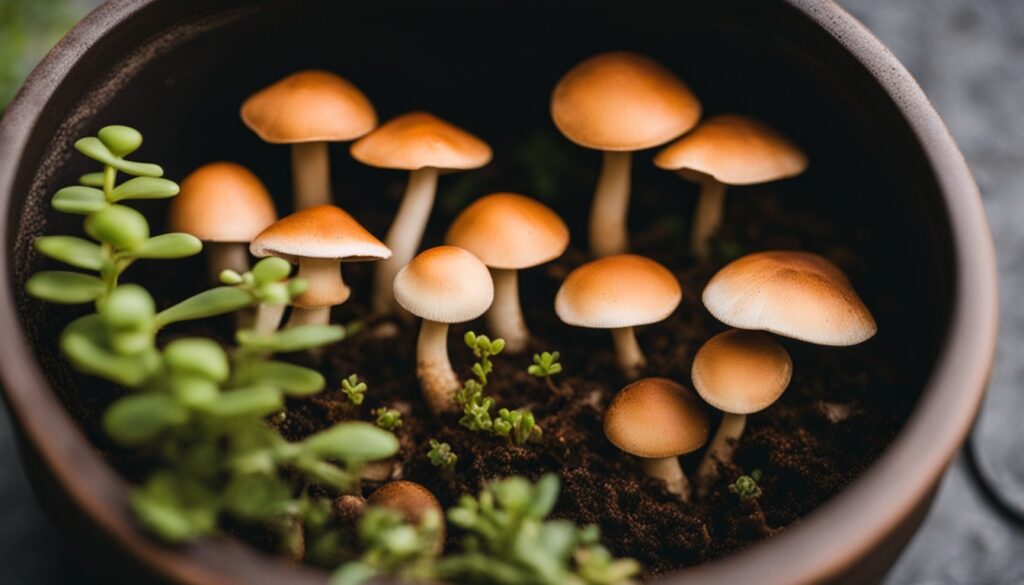Mushrooms growing in a succulent pot can be a concerning issue for plant enthusiasts. Not only do they detract from the aesthetic appeal of your succulent display, but they can also indicate underlying problems with the soil or environmental conditions. In this comprehensive blog post, we will delve into the various causes behind mushroom growth in succulent pots and offer effective solutions to address this issue. From proper watering techniques to soil sterilization methods, we will provide step-by-step guidance on how to prevent and eliminate mushrooms in your succulent pots. By implementing these strategies, you can ensure a healthy and vibrant succulent collection that is free from unwanted fungal growth.
Understanding Mushrooms in Succulent Pots
Unveiling the mystery of mushrooms in your succulent pot aids immensely in plant care. These fungi creep into succulent habitats due to specific conditions, playing a role often misunderstood yet crucial to decipher.
Mushrooms in succulent pots indicate specific environmental conditions, providing valuable insights for effective plant care and ensuring healthier succulents.
Our comprehensive guide aims to illuminate the presence of mushrooms in succulent pots. As we delve into this intriguing topic, we’ll unravel the interactions between these fungi and your succulents, leading to better care and healthier plants.
What Are Mushrooms and Why Do They Grow in Succulent Pots
Often confused with a disease, mushrooms appearing in your succulent pots signal something else. They are a type of fungus thriving on organic matter, indicating a lush micro-environment in your pot.
Conducive conditions such as excessive dampness or the presence of rotting organic material can lead to mushroom growth. Although rare in succulents due to their minimal water requirements, it can occur in pots with poor drainage or overwatered pots.
Common Types of Mushrooms Found in Succulent Pots
The presence of mushrooms in succulent pots signals multiple possible invaders. These opportunistic guests show up in various types, demonstrating the diversity of species that thrive in the unique environment succulent pots provide.
- Bird’s nest fungi, known for their cup-like formations filled with spore eggs
- Leucocoprinus birnbaumii, a bright yellow, often called the ‘flower pot parasol’
- Conocybe apala, a delicate, thin white variety
The Impact of Mushrooms on Succulents and Their Growth
The effect of mushrooms on succulent growth can be complex and often misunderstood. While mushrooms are essential components of natural ecosystems, their role in potted environments like succulent gardens is significantly different.
Predominantly, mushrooms in succulent pots signal excessive moisture or organic material. Yet, they aren’t necessarily detrimental to plant health. However, the damp conditions they imply may create an unfavorable environment for succulents, inviting other harmful fungi or pests.
An intriguing aspect of mushroom-succulent interactions is how the former might affect the latter’s health and development. Mushrooms, being decomposers, can influence soil nutrient levels, potentially affecting succulent growth depending on the mushroom species present.
Conversely, certain types of fungi might establish beneficial relationships with plants, aiding their nutrient absorption. Such symbiotic associations, although more common in wild ecosystems, could possibly emerge in succulent pots as well. Thus, the mushroom-succulent interplay is a multifaceted subject warranting further investigation.
Causes of Mushrooms Growing in Succulent Pots

Mushrooms in succulent pots often emerge due to specific conditions. Factors such as excessive moisture, organic matter in potting mix, or infected plant material can significantly contribute to this phenomenon.
Mushrooms are opportunistic organisms that can take advantage of various routes to propagate. Spores brought by wind or animals, and contamination via gardening tools are among the oft-cited reasons for unexpected mushroom growth in succulent pots.
Excessive Moisture and Poor Drainage
Excessive moisture and poor drainage are key culprits in the undesirable rise of mushrooms in succulent pots. When these two factors combine, the overwatered and waterlogged potting mix provides the ideal damp and nutrient-rich environment that mushrooms thrive in.
- Overwatering succulents, diluting concentration of nutrients in the soil
- Poorly drained pots retaining excess water, preventing oxygen from reaching plant roots
- Soggy potting media fostering fungal growth, attracting mushroom colonies
Organic Matter and Compost in Potting Mix
Compost and organic matter in the succulent potting mix can inadvertently act as mushroom magnets. While these ingredients boost soil fertility and nourish your succulents, they simultaneously provide the perfect environment for fungi, fostering the growth of mushrooms.
- The high nutrient content in compost provides ample nourishment for mushrooms.
- Organic matter retains more moisture, making it a suitable environment for fungi to thrive.
- Decomposing organic matter produces the organic compounds mushrooms require for growth.
- Spread of mushroom spores is easier in compost-rich soils due to the loose texture.
Infected Soil or Plant Material
Infected soil or plant material harbors hidden dangers, serving as catalysts for mushroom outbreaks in succulent pots. Pathogens and fungal spores buoyed in these mediums may lie dormant for extended periods, only to awaken under favorable conditions.
The silent invaders—fungus-laden soil, compost, or plant cuttings—unleash harmful spores into the potting medium. Their deceptive invisibility amplifies the risk, leading to unnoticed proliferation and ultimately mushroom infestations.
Regrettably, the ubiquitous nature of fungal spores makes their transfer remarkably easy. Contaminated gloves, tools, and even airborne dust can unwittingly introduce these invisible invaders into otherwise sterile succulent pots.
Once deposited, these stubborn spores create a haven for mushrooms. Thriving in nutrient-rich, moist potting mediums, their silent expansion poses a significant risk to the health of unsuspecting succulents over time.
Hence, understanding this intricate link between infected soil or plant material and mushroom growth is crucial for effective prevention. Only then can one implement measures to curb the silent, damaging onslaught of these unnoticed fungal invaders.
Spores Brought by Wind or Animals
Our succulent pots can become unintended hosts for mushrooms via unseen travellers – spores carried by the wind or animals. These tiny, lightweight particles journey great distances, unofficially transporting mushroom DNA into diverse environments including our succulent pots.
Nature’s delivery system is efficient, using wind and animals as vectors for mushroom dispersion. This can become challenging when monitoring succulent health as it introduces variable fungal elements into the potting mix, potentially instigating mushroom growth.
Contaminated Tools and Equipment
Even the most seasoned gardeners may overlook a prominent perpetrator of the mushroom invasion: contaminated tools and equipment. Pruners, trowels, and even watering cans harboring fungal spores can inoculate your succulent pots.
A quick swap from an infected to a healthy plant with a contaminated tool is enough to usher in unwanted fungi. Make no mistake, these are silent spreaders; the onset of mushroom growth remains unnoticed until it has firmly taken root.
Unsuspecting succulent enthusiasts often face a rude awakening when the mushroom colonies suddenly appear. Contaminated equipment acts as a stealthy fungal ferry, bringing the spore invasion right to your succulent pots’ doorstep.
The miniature landscapes of your succulent pots, elegantly manicured, can easily become a battleground for mushroom onslaught if caution is not exercised. Nothing escapes the mushroom spores when tools and equipment remain unsterilized.
Striving for a mushroom-free succulent haven entails a vigilant defense, starting with sterilizing gardening gear. Avoid the mushroom takeover; implement a routine of thorough cleaning, and bid farewell to the stealthy fungal invaders.
Preventing the Growth of Mushrooms in Succulent Pots

Formulating a foolproof strategy to shun mushroom proliferation in succulent pots demands meticulous attention to potting techniques, selection of well-draining soil and strict inhabitance of overwatering. Effective sterilization of tools and proper quarantining of new plants and soil also become pivotal.
By taking actionable measures such as careful irrigation, optimized location selection for pots, and regular cleaning of equipment, gardeners can significantly hinder the mushroom incursion in the realm of their succulent pots, thus maintaining their aesthetic appeal and overall health.
Using Well-Draining Soil and Proper Potting Techniques
To curb the mushroom invasion, the correct potting technique and use of well-draining soil are fundamental. Using such techniques not only promotes succulent growth but considerably diminishes the chance of any unwanted mushrooms sprouting up in your pots.
- Select a succulent pot with enough drainage holes at the bottom.
- Use well-draining soil specifically suited for succulents, which commonly includes a mixture of potting soil, coarse sand, and perlite or pumice.
- Avoid packing the soil too tightly. Over-packed soil can retain more water and hamper air circulation, leading to mushroom growth.
- Plant the succulents at appropriate depths to prevent waterlogging and subsequent fungal growth.
- Place a layer of pebbles at the bottom of the pot before adding soil to enhance drainage.
Avoiding Excessive Irrigation and Overwatering
Overwatering and excessive irrigation can lead to saturated soil, fostering an environment perfect for mushroom growth. By adjusting watering techniques, succulent owners can effectively reduce fungal spread and maintain an optimal succulent growing environment.
- Emphasize watering only when the top inch of soil becomes dry
- Use a watering can to control the amount of water added
- Avoid watering too often to allow the soil to dry out between applications
- Consider incorporating a soil moisture meter to avoid overwatering
- In areas of high rainfall, consider moving outdoor succulents to a covered area
Cleaning and Sterilizing Tools and Equipment
Sterilizing gardening tools and equipment eliminates potential breeding grounds for mushrooms. This critical step aids in disrupting the life cycle of the fungi, reducing the likelihood of a mushroom outbreak in your succulent pots.
Implementing a routine cleaning and sterilizing protocol can greatly hinder mushroom invasions. Make it a habit to clean and sterilize tools after every use to minimize the risk of spreading mushroom spores or other pathogens.
Remember that sterilizing is not reserved for just the infected tools. Regular sterilization of all garden instruments, pots, and equipment is key to curbing mushroom growth and maintaining the overall health of your succulent collection.
Quarantine New Plants and Soil
A prudent step in mushroom prevention, quarantining new plant and soil acquisitions epitomizes the phrase ‘safety first.’ This containment tactic can significantly limit the risk of introducing fungi spores into your succulent garden.
A new plant can house unseen mushroom spores, even if it shows no signs of mushrooms itself. Quarantine creates a buffer, giving enough time for any potential fungi to manifest before integrating the plant with your succulent collection.
Just as new plants can be carriers, new soil batches may also harbor mushroom spores, especially if they contain organic compost. Quarantining soil provides an added level of protection, enabling early detection and management of fungal proliferation.
The tactical approach of quarantining new plants and soil is not time-consuming or difficult. Yet, it presents a robust line of defense against mushroom spore intrusion, securing the health and beauty of your succulent pots.
Every little step towards containment counts. With the simple act of quarantining new plants and soil, you strengthen your arsenal against mushroom invasion, ensuring your succulents continue to thrive unhampered by unnecessary fungal growth.
Choosing the Right Location for Succulent Pots
When it comes to thwarting mushroom growth, location is key. The right positioning of your succulents, considering aspects like light and temperature conditions, can greatly diminish the proliferation of fungi. A location with mild, consistent temperatures and enough light to support succulent growth, but not excessive moisture, is ideal for fending off mushrooms.
Unsuitable environmental conditions often encourage mushroom growth. Therefore, situating your succulent pots in an area that aligns more with their native desert conditions rather than the moist, cool environments mushrooms favor can help limit their occurrence. Elevating the pots and providing good airflow can also contribute to better moisture management and thus less fungal growth.
Moreover, the strategic placement of succulent pots away from areas prone to mushroom exposure – such as compost piles, decayed wood, or heavily vegetated areas – can further optimize the protection against unwanted fungi. Remember that being proactive with position optimization can help you outsmart mushrooms and keep your succulents healthy.
Managing Mushrooms in Established Succulent Pots

Even in established succulent pots, managing mushroom invasions remains feasible. Through meticulous techniques such as the manual removal of visible growth, application of suitable fungicides along with natural remedies, and adjustments in moisture levels with an added focus on improving drainage, one can successfully control mushroom infestations.
In cases when invasive mushrooms have seized your succulent pots, don’t go into panic mode. Devise strategies including regular inspection and quick removal of mushroom spores, usage of fungicidal treatments as precautionary measures, and optimization of watering practices to maintain an environment unfavorable for mushroom growth.
Removing Mushrooms Manually
Meticulously excising mushrooms from your succulent pots delivers instant relief, clearing the pot of visible fungi. This hands-on method demands careful handling to avoid damaging the succulents or inadvertently dislodging spores, exacerbating the issue.
Begin by firming securing the succulent. With a pair of sterilized tweezers, gently extract the mushrooms from soil. Remember, fungi have delicate structures — ensure you lift from the base, minimizing chances of spore dispersion.
Post-extraction, assess your pot for any residual mushrooms. It is essential to remove all traces, leaving no potential breeding ground for future mushroom growth. Be thorough, as overlooked mushrooms can unfurl a fresh set of spores.
After removal, dispose of the mushrooms responsibly. Toss them into a sealed bag and put in trash, eliminating any likelihood of their return. Wash your hands and sterilize your tools to curb the unwanted spread of fungal spores.
Applying Fungicides and Natural Remedies
The competitive home gardener might turn to fungicides as a formidable defense against mushroom invaders. Ensure to apply these products as per the directions, taking precautions to avoid harming your succulents.
In contrast, natural remedies, such as a cinnamon solution or a diluted vinegar spray, can act as environmental-friendly alternatives. The crucial point is to employ them judiciously and timely to prevent mushroom proliferation while safeguarding the succulents.
Adjusting Moisture Levels and Improving Drainage
Plants thrive on a delicate balance of moisture, and mushrooms are no exception. Tweaking this dynamic by adjusting moisture content can significantly influence mushroom growth in succulent pots. Well-executed adjustments deter overgrowth, encouraging a healthier environment for your succulents.
A majority of mushroom species proliferate in damp conditions. By improving the drainage system of your succulent pots, you can control this dampness, effectively reigning over the ‘rain’ that mushrooms crave.
A well-draining soil not only prevents water stagnation but also inhibits the proliferation of mushrooms. This careful selection of soil and amendments, coupled with appropriate pot design, is pivotal to effective moisture management.
Do keep in mind that succulents, contrary to mushrooms, favor dry, arid climates. Therefore, maintaining appropriate moisture levels not only aids in controlling mushroom growth but also cultivates a more conducive environment for the succulents themselves.
A methodical approach towards drainage can create a significant impact. Advanced tactics can include slanting pot surfaces or employing gravel for increased efficacy, acting as strong preventive measures against unwanted mushroom growth in succulent pots.
Conclusion: Keeping Mushrooms at Bay in Succulent Pots
Reflecting on potent techniques to curb mushroom growth in succulent pots, it’s evident that careful watering and selection of well-draining soil are crucial. Similarly, frequent sterilization of gardening tools and proper quarantining of new plants can protect existing succulents.
On recapping effective measures to control mushroom infestation, manual removal and application of fungicides or natural remedies are exemplary. It’s equally imperative to adjust moisture levels and improve drainage, ensuring the substrate isn’t overly damp.
- Careful watering to avoid waterlogged conditions.
- Selection of well-draining soil for proper aeration.
- Regular sterilization of gardening tools.
- Proper quarantine procedures for new plants.
- Manual removal of growing mushrooms.
- Application of fungicides or natural remedies.
- Adjustment of moisture levels and improvement of drainage.
FAQ: Mushrooms Growing in Succulent Pots
Understanding the causes of mushrooms growing in succulent pots is crucial for maintaining healthy plants. Here are some frequently asked questions about this issue and their brief answers:
Why are mushrooms growing in my succulent pot?
Mushrooms can appear in succulent pots due to various factors, such as overwatering, poor drainage, organic matter in the soil, or contaminated potting mix. These conditions provide an ideal environment for fungal spores to germinate and grow.
Are mushrooms harmful to my succulents?
In most cases, mushrooms themselves are not harmful to succulents. However, their presence may indicate an imbalance in moisture levels or other underlying issues that can affect plant health. It’s important to address these issues to prevent any negative impact on your succulents.
How can I prevent mushrooms from growing in my succulent pot?
To prevent mushroom growth, ensure proper watering practices by allowing the soil to dry out between waterings and use a well-draining potting mix. Avoid using organic matter or unsterilized soil, as they can promote fungal growth. Additionally, providing adequate airflow and maintaining a clean environment around your succulent pots can help prevent mushroom growth.
What should I do if mushrooms appear in my succulent pot?
If mushrooms appear, carefully remove them and their base to prevent spore dispersal. Adjust watering frequency and consider repotting your succulents using sterilized soil and clean containers. If the issue persists, it may be helpful to consult a plant expert for further guidance and recommendations tailored to your specific situation.
Can I use fungicides to eliminate mushrooms?
While fungicides can be effective in controlling fungal growth, they are not recommended for use on succulents. Fungicides may harm the plants themselves, and it’s preferable to address the underlying causes of mushroom growth instead. Focus on maintaining proper growing conditions and implementing preventive measures to discourage mushroom growth.
Remember, taking proactive steps to address the causes of mushroom growth is key to maintaining a healthy environment for your succulents and ensuring their long-term well-being. With proper care and attention, you can enjoy a beautiful succulent collection free from unwanted mushrooms.
Conclusion
Plant lovingly, water responsibly, and watch vigilantly. Mushrooms may appear as unwanted guests in your succulent pots, but with a deeper understanding and proper management, they become less of a terror and more a token of a vibrant ecosystem.
- Final Thoughts: Making Peace With Mushrooms in Succulent Pots
- Summary: Understanding and Tackling Mushroom Manifestation in Succulents

